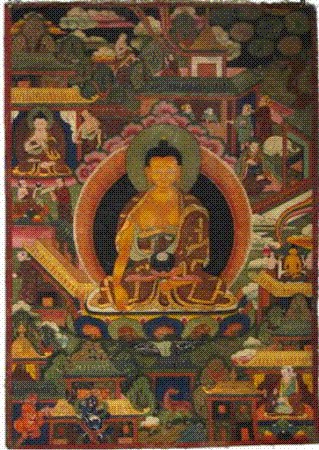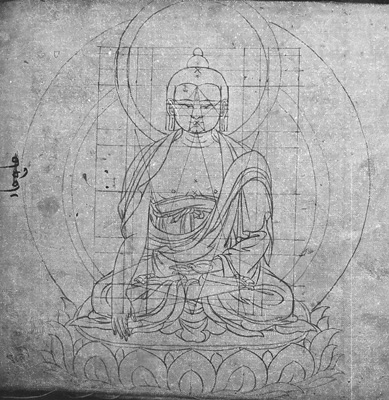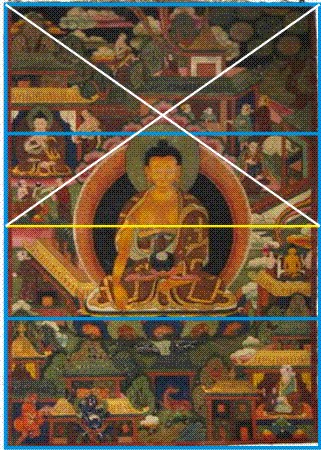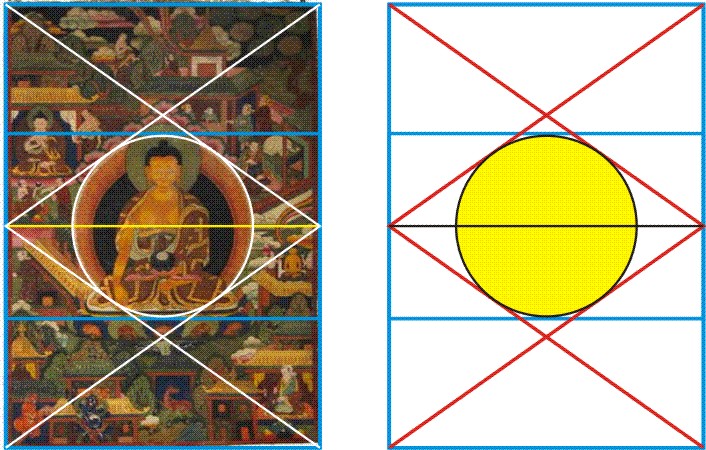
by
Michael S. Schneider

Siddhartha Gautama, of course, was a spiritual teacher from ancient India and the historical founder of Buddhism. His name "Buddha" literally means "awakened". He was also known as Shakyamuni, meaning “Sage of the Shakyas”, his family tribe at the foot of the Himalaya mountains. This thangka painting depicts the Shakayamuni Buddha in meditation. As a sacred object, it was designed with great care and consideration to the symbolism of colors, objects, positions and more. Buddhist art is well known for its strict geometric guidelines for drawing, painting and sculpting the Buddha'a proper proportions in great detail.

We won't go into these details here, but we're interested in the structure of the overall painting. Below, left, a blue square was drawn from the painting's top. Notice that one of his hands reaches down to touch the bottom of our unseen blue square, in the well-known hand gesture (bhumisparsha mudra) invoking the earth to bear witness that he has vanquished delusion and attained enlightenment. Notice also how the square's (white) diagonals cross at his forehead, his ajna chakra or "third eye". These diagonals are swung down (white arcs) and reach the bottom of the painting. This tells us that the whole canvas is a root-two rectangle, since the diagonal of any square, now transferred to the long side of the rectangle, is the square-root-of-two (1.414...) times its side. Symbolically, the root-two rectangle represents "birth" and "new beginnings" because it's the very first of infinitely many root-rectangles to emerge from the basic square, symbol of earth, matter and identification with the ordinary, sensory world. The birth symbolized here is a transformation from the sleep of ordinary life to the enlightened Buddha nature within us. Below, right, an identical (red) square was drawn from the bottom, indicating the golden top of his knot of hair.

Below, the blue lines of the two squares remain, and a yellow horizontal line divides the whole canvas in half. A unique characteristic of the root-two rectangle is that when divided this way, each half is a turned, miniature model of the whole root-two rectangle. Unity is maintained amidst diversity. White diagonals are drawn across the upper rectangle. Notice how they define the upper curve of the large aura around his body.

Below (left), white diagonals are also drawn in the lower rectangle, tangent to the bottom of the aura. A circle has been inscribed within the diamond made by the diagonals showing how the aura was defined. Below (right) we see the painting's essential geometric scheme. It is a commonly used framework in ancient and modern Buddhist paintings and can also be found in the art, crafts and architecture of most other religions and cultures. Here it conveys for its admirers the balance and inner calm attained by the enlightened Buddha sage. There is much more to the design of this painting. Further placement of various elements within it can be discovered by drawing squares, diagonals and arcs starting with this simple framework. You might find other thangka paintings proportioned as root-two rectangles and explore their unseen guidelines this way.
